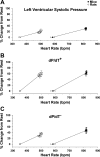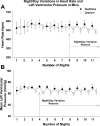Ventricular function during exercise in mice and rats
- PMID: 22012697
- PMCID: PMC3349383
- DOI: 10.1152/ajpregu.00340.2011
Ventricular function during exercise in mice and rats
Abstract
The mouse has many advantages over other experimental models for the molecular investigation of left ventricular (LV) function. Accordingly, there is a keen interest in, as well as an intense need for, a conscious, chronically instrumented, freely moving mouse model for the determination of cardiac function. To address this need, we used a telemetry device for repeated measurements of LV function in conscious mice at rest and during exercise. For reference, we compared the responses in mice to the responses in identically instrumented conscious rats. The transmitter body of the telemetry device (rat PA-C40; mouse PA-C10; Data Sciences International, St. Paul, MN) was placed in the intraperitoneal space through a ventral abdominal approach (rat) or subcutaneously on the left flank (mouse). The pressure sensor, located within the tip of a catheter, was inserted into the left ventricle through an apical stab wound (18 gauge for rat; 21 gauge for mouse) for continuous, nontethered, recordings of pulsatile LV pressure. A minimum of 1 wk was allowed for recovery and for the animals to regain their presurgical weight. During the recovery period, the animals were handled, weighed, and acclimatized to the laboratory, treadmill, and investigators. Subsequently, LV parameters were recorded at rest and during a graded exercise test. The results document, for the first time, serial assessment of ventricular function during exercise in conscious mice and rats. This methodology may be adopted for advancing the concepts and ideas that drive cardiovascular research.
Figures







Similar articles
-
Simultaneous measurement of arterial and left ventricular pressure in conscious freely moving rats by telemetry.J Pharmacol Toxicol Methods. 2016 May-Jun;79:23-33. doi: 10.1016/j.vascn.2016.01.003. Epub 2016 Jan 9. J Pharmacol Toxicol Methods. 2016. PMID: 26778372
-
Chronic measurement of left ventricular pressure in freely moving rats.J Appl Physiol (1985). 2013 Dec;115(11):1672-82. doi: 10.1152/japplphysiol.00683.2013. Epub 2013 Oct 10. J Appl Physiol (1985). 2013. PMID: 24114699
-
Translational assessment of cardiac contractility by echocardiography in the telemetered rat.J Pharmacol Toxicol Methods. 2016 Jan-Feb;77:24-32. doi: 10.1016/j.vascn.2015.09.005. Epub 2015 Sep 30. J Pharmacol Toxicol Methods. 2016. PMID: 26427954
-
Repeated assessment of cardiovascular and respiratory functions using combined telemetry and whole-body plethysmography in the rat.J Pharmacol Toxicol Methods. 2009 Sep-Oct;60(2):117-29. doi: 10.1016/j.vascn.2009.07.003. Epub 2009 Jul 17. J Pharmacol Toxicol Methods. 2009. PMID: 19616108
-
Direct blood pressure monitoring in laboratory rodents via implantable radio telemetry.Methods Mol Biol. 2009;573:57-73. doi: 10.1007/978-1-60761-247-6_4. Methods Mol Biol. 2009. PMID: 19763922 Review.
Cited by
-
Animal Models of Exercise From Rodents to Pythons.Circ Res. 2022 Jun 10;130(12):1994-2014. doi: 10.1161/CIRCRESAHA.122.320247. Epub 2022 Jun 9. Circ Res. 2022. PMID: 35679366 Free PMC article. Review.
-
Type-2 diabetic aldehyde dehydrogenase 2 mutant mice (ALDH 2*2) exhibiting heart failure with preserved ejection fraction phenotype can be determined by exercise stress echocardiography.PLoS One. 2018 Apr 20;13(4):e0195796. doi: 10.1371/journal.pone.0195796. eCollection 2018. PLoS One. 2018. PMID: 29677191 Free PMC article.
-
Cardiac electrophysiology and the susceptibility to sustained ventricular tachycardia in intact, conscious mice.Am J Physiol Heart Circ Physiol. 2014 Apr 15;306(8):H1213-21. doi: 10.1152/ajpheart.00780.2013. Epub 2014 Feb 21. Am J Physiol Heart Circ Physiol. 2014. PMID: 24561859 Free PMC article.
-
Rescue and Translocation of Hispaniola Hutia (Plagiodontia aedium) in Pueblo Viejo, Cotuí Mining Concession Area.Ecol Evol. 2024 Nov 13;14(11):e70560. doi: 10.1002/ece3.70560. eCollection 2024 Nov. Ecol Evol. 2024. PMID: 39544391 Free PMC article.
-
The 24 h pattern of arterial pressure in mice is determined mainly by heart rate-driven variation in cardiac output.Physiol Rep. 2014 Nov 26;2(11):e12223. doi: 10.14814/phy2.12223. Print 2014 Nov 1. Physiol Rep. 2014. PMID: 25428952 Free PMC article.
References
-
- Arber S, Hunter JJ, Ross J, Jr., Hongo M, Sansig G, Borg J, Perriard JC, Chien KR, Caroni P. MLP-deficient mice exhibit a disruption of cardiac cytoarchitectural organization, dilated cardiomyopathy, and heart failure. Cell 88: 393– 403, 1997 - PubMed
-
- Butz GM, Davisson RL. Long-term telemetric measurement of cardiovascular parameters in awake mice: a physiological genomics tool. Physiol Genomics 5: 89– 97, 2001 - PubMed
-
- Chaves AA, Weinstein DM, Bauer JA. Non-invasive echocardiographic studies in mice: influence of anesthetic regimen. Life Sci 69: 213– 222, 2001 - PubMed
-
- Chu G, Dorn GW, Luo W, Harrer JM, Kadambi VJ, Walsh RA, Kranias EG. Monomeric phospholamban overexpression in transgenic mouse hearts. Circ Res 81: 485– 492, 1997 - PubMed
-
- Collins FS, Patrinos A, Jordan E, Chakravarti A, Gesteland R, Walters L. New goals for the U.S. Human Genome Project: 1998–2003. Science 282: 682– 689, 1998 - PubMed
Publication types
MeSH terms
Substances
Grants and funding
LinkOut - more resources
Full Text Sources
Molecular Biology Databases

